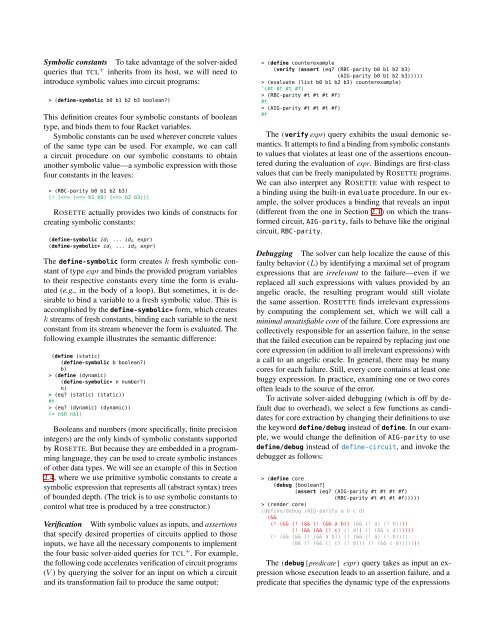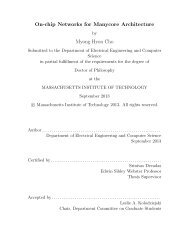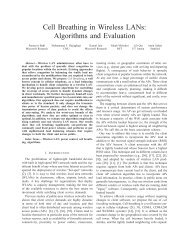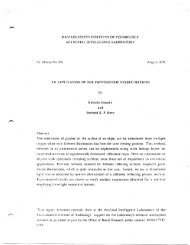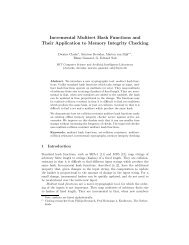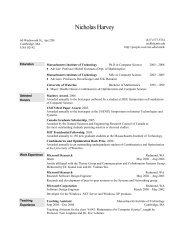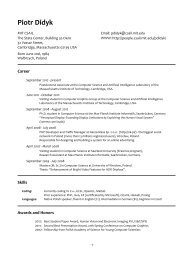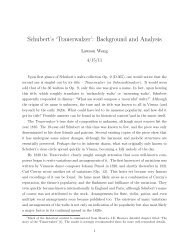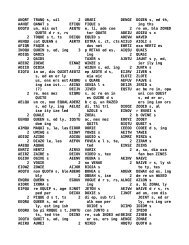Growing Solver-Aided Languages with ROSETTE - People - MIT
Growing Solver-Aided Languages with ROSETTE - People - MIT
Growing Solver-Aided Languages with ROSETTE - People - MIT
You also want an ePaper? Increase the reach of your titles
YUMPU automatically turns print PDFs into web optimized ePapers that Google loves.
Symbolic constants To take advantage of the solver-aided<br />
queries that TCL + inherits from its host, we will need to<br />
introduce symbolic values into circuit programs:<br />
> (define-symbolic b0 b1 b2 b3 boolean?)<br />
This definition creates four symbolic constants of boolean<br />
type, and binds them to four Racket variables.<br />
Symbolic constants can be used wherever concrete values<br />
of the same type can be used. For example, we can call<br />
a circuit procedure on our symbolic constants to obtain<br />
another symbolic value—a symbolic expression <strong>with</strong> those<br />
four constants in the leaves:<br />
> (RBC-parity b0 b1 b2 b3)<br />
(! ( ( b1 b0) ( b2 b3)))<br />
<strong>ROSETTE</strong> actually provides two kinds of constructs for<br />
creating symbolic constants:<br />
(define-symbolic id 1 ... id k expr)<br />
(define-symbolic* id 1 ... id k expr)<br />
The define-symbolic form creates k fresh symbolic constant<br />
of type expr and binds the provided program variables<br />
to their respective constants every time the form is evaluated<br />
(e.g., in the body of a loop). But sometimes, it is desirable<br />
to bind a variable to a fresh symbolic value. This is<br />
accomplished by the define-symbolic* form, which creates<br />
k streams of fresh constants, binding each variable to the next<br />
constant from its stream whenever the form is evaluated. The<br />
following example illustrates the semantic difference:<br />
(define (static)<br />
(define-symbolic b boolean?)<br />
b)<br />
> (define (dynamic)<br />
(define-symbolic* n number?)<br />
n)<br />
> (eq? (static) (static))<br />
#t<br />
> (eq? (dynamic) (dynamic))<br />
(= n$0 n$1)<br />
Booleans and numbers (more specifically, finite precision<br />
integers) are the only kinds of symbolic constants supported<br />
by <strong>ROSETTE</strong>. But because they are embedded in a programming<br />
language, they can be used to create symbolic instances<br />
of other data types. We will see an example of this in Section<br />
2.4, where we use primitive symbolic constants to create a<br />
symbolic expression that represents all (abstract syntax) trees<br />
of bounded depth. (The trick is to use symbolic constants to<br />
control what tree is produced by a tree constructor.)<br />
Verification With symbolic values as inputs, and assertions<br />
that specify desired properties of circuits applied to those<br />
inputs, we have all the necessary components to implement<br />
the four basic solver-aided queries for TCL + . For example,<br />
the following code accelerates verification of circuit programs<br />
(V ) by querying the solver for an input on which a circuit<br />
and its transformation fail to produce the same output:<br />
> (define counterexample<br />
(verify (assert (eq? (RBC-parity b0 b1 b2 b3)<br />
(AIG-parity b0 b1 b2 b3)))))<br />
> (evaluate (list b0 b1 b2 b3) counterexample)<br />
’(#t #t #t #f)<br />
> (RBC-parity #t #t #t #f)<br />
#t<br />
> (AIG-parity #t #t #t #f)<br />
#f<br />
The (verify expr) query exhibits the usual demonic semantics.<br />
It attempts to find a binding from symbolic constants<br />
to values that violates at least one of the assertions encountered<br />
during the evaluation of expr. Bindings are first-class<br />
values that can be freely manipulated by <strong>ROSETTE</strong> programs.<br />
We can also interpret any <strong>ROSETTE</strong> value <strong>with</strong> respect to<br />
a binding using the built-in evaluate procedure. In our example,<br />
the solver produces a binding that reveals an input<br />
(different from the one in Section 2.1) on which the transformed<br />
circuit, AIG-parity, fails to behave like the original<br />
circuit, RBC-parity.<br />
Debugging The solver can help localize the cause of this<br />
faulty behavior (L) by identifying a maximal set of program<br />
expressions that are irrelevant to the failure—even if we<br />
replaced all such expressions <strong>with</strong> values provided by an<br />
angelic oracle, the resulting program would still violate<br />
the same assertion. <strong>ROSETTE</strong> finds irrelevant expressions<br />
by computing the complement set, which we will call a<br />
minimal unsatisfiable core of the failure. Core expressions are<br />
collectively responsible for an assertion failure, in the sense<br />
that the failed execution can be repaired by replacing just one<br />
core expression (in addition to all irrelevant expressions) <strong>with</strong><br />
a call to an angelic oracle. In general, there may be many<br />
cores for each failure. Still, every core contains at least one<br />
buggy expression. In practice, examining one or two cores<br />
often leads to the source of the error.<br />
To activate solver-aided debugging (which is off by default<br />
due to overhead), we select a few functions as candidates<br />
for core extraction by changing their definitions to use<br />
the keyword define/debug instead of define. In our example,<br />
we would change the definition of AIG-parity to use<br />
define/debug instead of define-circuit, and invoke the<br />
debugger as follows:<br />
> (define core<br />
(debug [boolean?]<br />
(assert (eq? (AIG-parity #t #t #t #f)<br />
(RBC-parity #t #t #t #f)))))<br />
> (render core)<br />
(define/debug (AIG-parity a b c d)<br />
(&&<br />
(! (&& (! (&& (! (&& a b)) (&& (! a) (! b))))<br />
(! (&& (&& (! c) (! d)) (! (&& c d))))))<br />
(! (&& (&& (! (&& a b)) (! (&& (! a) (! b))))<br />
(&& (! (&& (! c) (! d))) (! (&& c d)))))))<br />
The (debug [predicate ] expr) query takes as input an expression<br />
whose execution leads to an assertion failure, and a<br />
predicate that specifies the dynamic type of the expressions


